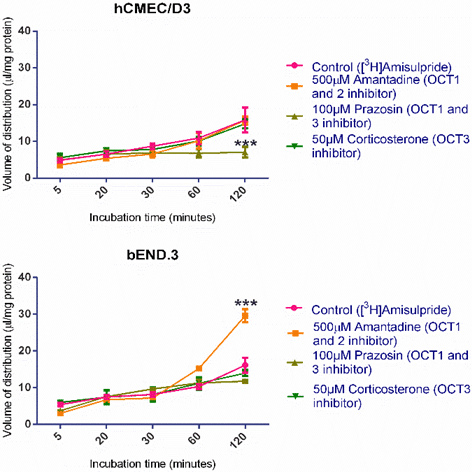Exploring The Interaction Of Amisulpride With Influx And Efflux Transporters Expressed At The Blood-Brain Barrier
There is considerable interest in blood-brain barrier (BBB) dysfunction in the Alzheimer’s disease (AD) process and its impact on drug delivery. This may have particular relevance for antipsychotic medication. Research into amisulpride use in people with AD strongly implicates central pharmacokinetic mechanisms in antipsychotic sensitivity, as high central dopamine receptor occupancy is observed following very low doses(1). This study aims to test the hypothesis that both influx and efflux transporters contribute to the delivery of amisulpride to the human and mouse brain in vitro. To investigate this, human (hCMEC/D3) and mouse (bEND.3) brain endothelial cell lines were employed. Accumulation assays were performed(2) using 3H amisulpride and 14C sucrose as a vascular space marker (n=3 plates with 6 wells per treatment) in the absence and presence of transporter substrates /inhibitors. Western blots and immuno fluorescence determined transporter expression. Results revealed that there was a low affinity uptake transporter for amisulpride in both cell lines as suggested by unlabelled amisulpride data (not shown). This is likely to be a system transporting organic cations since amisulpride is positively charged at physiological pH.
Data (see figures) suggested that this is hOCT1and that amisulpride is also effluxed by a plasma-membrane monoamine transporter (PMAT) or a multidrug and toxin extrusion protein 1 (MATE1) (3;4). There was no observed amisulpride interaction with BCRP, P-gp or MRP (data not shown). The increased central occupancy observed with administration of low doses of amisulpride could be related to age and/or disease-specific changes in expression of the specific uptake and efflux transporters of amisulpride. (1) Clark-Papasavas, C. et al., (2014). Int J. Ger Psychiatry 29: 1001-1009. (2) Watson et al., (2012). Brain Res 1436: 111-121. (3) Geier et al., (2013). Clin Pharm Ther. 94: 636-639. (4) Suzuki et al. (2015). Biopharm. Drug Dispos. (2015) 36: 126-137). Funded by the King’s College London Alzheimer’s Research Network Centre.
|



